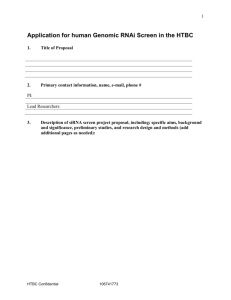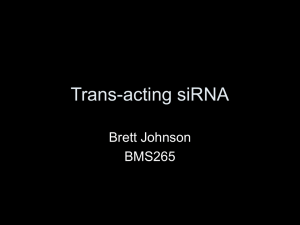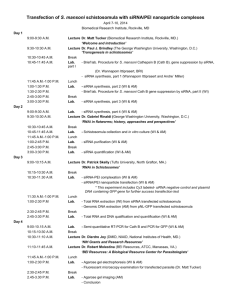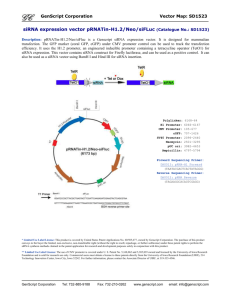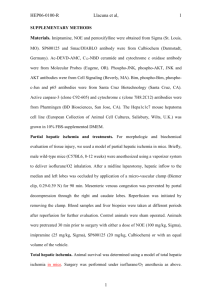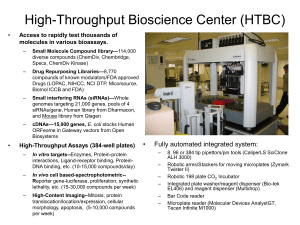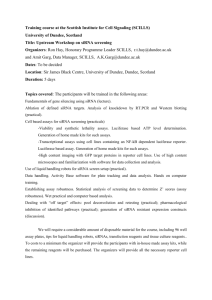Custom RNA synthesis
advertisement
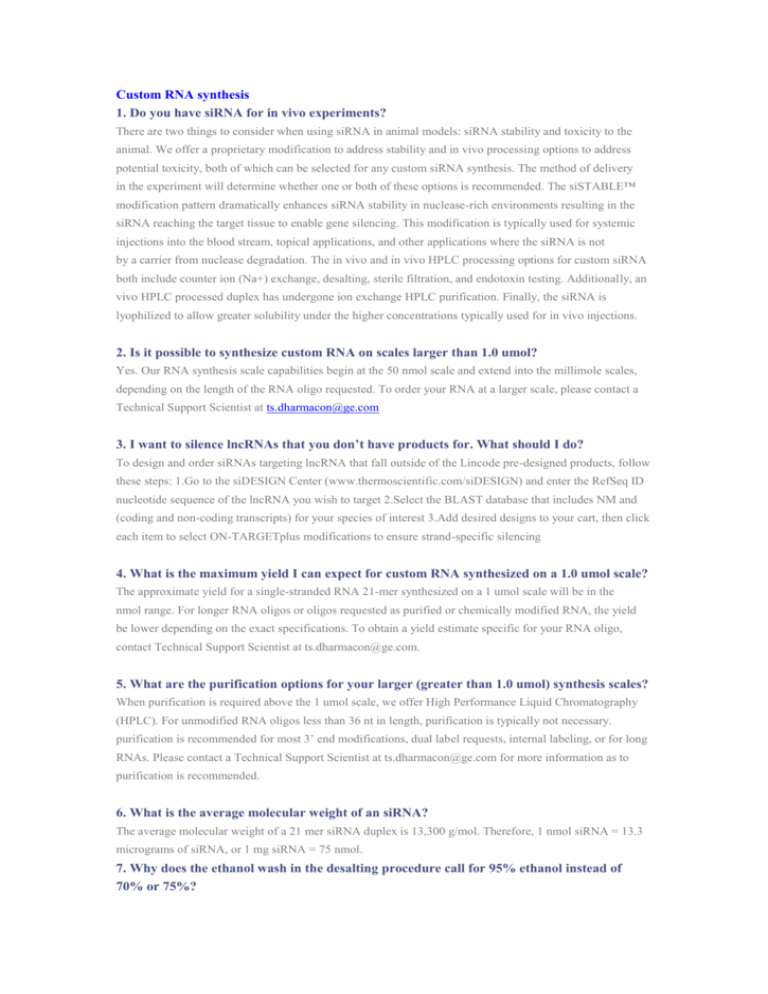
Custom RNA synthesis 1. Do you have siRNA for in vivo experiments? There are two things to consider when using siRNA in animal models: siRNA stability and toxicity to the animal. We offer a proprietary modification to address stability and in vivo processing options to address potential toxicity, both of which can be selected for any custom siRNA synthesis. The method of delivery in the experiment will determine whether one or both of these options is recommended. The siSTABLE™ modification pattern dramatically enhances siRNA stability in nuclease-rich environments resulting in the siRNA reaching the target tissue to enable gene silencing. This modification is typically used for systemic injections into the blood stream, topical applications, and other applications where the siRNA is not by a carrier from nuclease degradation. The in vivo and in vivo HPLC processing options for custom siRNA both include counter ion (Na+) exchange, desalting, sterile filtration, and endotoxin testing. Additionally, an vivo HPLC processed duplex has undergone ion exchange HPLC purification. Finally, the siRNA is lyophilized to allow greater solubility under the higher concentrations typically used for in vivo injections. 2. Is it possible to synthesize custom RNA on scales larger than 1.0 umol? Yes. Our RNA synthesis scale capabilities begin at the 50 nmol scale and extend into the millimole scales, depending on the length of the RNA oligo requested. To order your RNA at a larger scale, please contact a Technical Support Scientist at ts.dharmacon@ge.com 3. I want to silence lncRNAs that you don’t have products for. What should I do? To design and order siRNAs targeting lncRNA that fall outside of the Lincode pre-designed products, follow these steps: 1.Go to the siDESIGN Center (www.thermoscientific.com/siDESIGN) and enter the RefSeq ID nucleotide sequence of the lncRNA you wish to target 2.Select the BLAST database that includes NM and (coding and non-coding transcripts) for your species of interest 3.Add desired designs to your cart, then click each item to select ON-TARGETplus modifications to ensure strand-specific silencing 4. What is the maximum yield I can expect for custom RNA synthesized on a 1.0 umol scale? The approximate yield for a single-stranded RNA 21-mer synthesized on a 1 umol scale will be in the nmol range. For longer RNA oligos or oligos requested as purified or chemically modified RNA, the yield be lower depending on the exact specifications. To obtain a yield estimate specific for your RNA oligo, contact Technical Support Scientist at ts.dharmacon@ge.com. 5. What are the purification options for your larger (greater than 1.0 umol) synthesis scales? When purification is required above the 1 umol scale, we offer High Performance Liquid Chromatography (HPLC). For unmodified RNA oligos less than 36 nt in length, purification is typically not necessary. purification is recommended for most 3’ end modifications, dual label requests, internal labeling, or for long RNAs. Please contact a Technical Support Scientist at ts.dharmacon@ge.com for more information as to purification is recommended. 6. What is the average molecular weight of an siRNA? The average molecular weight of a 21 mer siRNA duplex is 13,300 g/mol. Therefore, 1 nmol siRNA = 13.3 micrograms of siRNA, or 1 mg siRNA = 75 nmol. 7. Why does the ethanol wash in the desalting procedure call for 95% ethanol instead of 70% or 75%? Our scientists have optimized the desalting conditions and found that 95% ethanol works well for complete removal of excess salts. 8. Will an siRNA designed to target the human version of a particular gene work in a different species? siRNAs designed specifically to target human genes are not expected to silence homologs in other species. Thus far, of the siRNAs designed for a gene in a particular species, few cross-target another species, even in cases where a high identity exists between the gene sequences of two species. There are instances where siRNAs can be specifically designed to be functional in two or more species, but this involves careful siRNA design and bioinformatics analysis. The online siDESIGN Center provides the necessary tools to support cross-species design requests. Contact Dharmacon Technical Support (ts.dharmacon@ge.com) for more information. 9. Will an siRNA designed to target the human version of a particular gene work in a different species? siRNAs designed specifically to target human genes are not expected to silence homologs in other species. Thus far, of the siRNAs designed for a gene in a particular species, few cross-target another species, even in cases where a high identity exists between the gene sequences of two species. There are instances where siRNAs can be specifically designed to be functional in two or more species, but this involves careful siRNA design and bioinformatics analysis. The online siDESIGN Center provides the necessary tools to support cross-species design requests. Contact Dharmacon Technical Support (ts.dharmacon@ge.com) for more information. 10.What are the yields for modified oligos? Most 5'-modifications are added as phosphoramidites at the final step of synthesis with ~90-95% coupling efficiencies, resulting in a slight loss in final yield versus the guaranteed minimum for unmodified oligos. Final yields for oligos with 3' or internal labels will depend on the coupling efficiency and subsequent purification steps required. The yields for these modifications are typically much lower. Post synthesis processing options (purification, desalting/deprotection, etc) will also reduce the final yield of the oligo. We make every effort to provide the highest quality and the best yields possible. If you need a guaranteed final yield for any custom RNA or siRNA oligo please contact DharmaconTechnical Support for more information (ts.dharmacon@ge.com) or to request a price quote. 11. What are the yields for modified oligos? Most 5'-modifications are added as phosphoramidites at the final step of synthesis with ~90-95% coupling efficiencies, resulting in a slight loss in final yield versus the guaranteed minimum for unmodified oligos. Final yields for oligos with 3' or internal labels will depend on the coupling efficiency and subsequent purification steps required. The yields for these modifications are typically much lower. Post synthesis processing options (purification, desalting/deprotection, etc) will also reduce the final yield of the oligo. We make every effort to provide the highest quality and the best yields possible. If you need a guaranteed final yield for any custom RNA or siRNA oligo please contact DharmaconTechnical Support for more information (ts.dharmacon@ge.com) or to request a price quote. 12. Is it necessary to remove the 2'-ACE protection from the siRNA duplexes prior to transfection? The 2'-ACE group needs to be removed from the RNA oligo prior to use in experiments. The 2'-ACE protecting group is removed during normal processing for all our catalog siRNA products as well as all custom siRNA syntheses except where option A1 is requested at the time of order. 13. What sequence do I need to provide to order siRNA? The 19-nucleotide target sequence of the siRNA needs to be entered into the Target Sequence box, which will automatically calculate and display both the sense and antisense sequences. The overhang composition is specified separately. Many times investigators publish siRNA sequences using an AA-N19 template. In most cases, the AA leader sequence should be removed and the remaining 19 nucleotides provided in the target sequence box. We also strongly recommend that the siRNA sequence be verified with the authors of any reference manuscript if the sequence is in question. 14. Can I order a custom miRNA miRIDIAN mimic or inhibitor? Yes, we do offer custom synthesis services for miRIDIAN products. We can work with you to design miRIDIAN products to complement miRNAs not currently represented as catalog items. We can also customize our current catalog items with a variety of modifications to meet your research needs. Please contact our Technical Support department at ts.dharmacon@ge.com for a customized price quote. 15.What are recommended purification methods for 5'-modified RNA oligos? Modified bases or labels added during solid-phase synthesis, such as most 5'-modifications, typically do not require further purification. Purification is recommended for modifications or labels added post-synthetically. Modified or labeled RNAs are generally purified by HPLC purification which we can provide as an optional service. Additionally, it is highly recommended that any purification steps be performed on 2'-ACE protected RNA oligos since the protecting groups help limit possible secondary structure, resulting in a tighter band and better purification. 16.What modified bases are available for internal labeling? Currently, we recommend 5-amino-allyl-U (5-N-U). All available modifications, including pricing, synthesis scales and structures, may be viewed on the Pricing and Modifications page listed on the website under the Custom RNA menu. New modifications are always in development, so please contact Technical Support (ts.dharmacon@ge.com) with your specific requests. 17. How are fluorescently labeled siRNAs detected? Fluorophore labeled duplexes are popular items for optimizing transfection conditions. Uptake of the labeled pre-synthesized siRNAs is readily detected either by flow cytometry or by fluorescence confocal microscopy. We recommend that you use protocols and procedures that are specific for your optical system and software package to detect the fluorescently labeled cells. It is also important to consider that fluorescence may not correlate with siRNA function unless the siRNA has been modified specifically for nuclease resistance (e.g., siGLO control duplexes). 18. What quantity of siRNA is needed to conduct a cell culture experiment? We recommend that a screening concentration of 100 nM* final siRNA concentration be used for initial experiments, this concentration may subsequently be titrated down to use less reagent while maintaining potency of knockdown. 1 nmol of siRNA is sufficient for preparation of 10 mL of a 100 nM siRNA solution. This is generally enough volume to transfect one complete 96-well or 24-well plate. * 100 nM = 100 nmol/L = 100 pmol/mL = 100 fmol/uL 19. How can I get more 5X siRNA Buffer? The 5X siRNA Buffer is available for purchase on our web site. Alternatively, under RNase-free conditions, you may prepare additional 5X siRNA Buffer. Composition: 300mM KCl, 30mM HEPES-pH 7.5, 1.0mM MgCl2 Consumables: 1.100 mL sterile bottle or flask 2.15 mL conical tube Chemicals: 1.RNase-free water 2.Potassium chloride 3.HEPES-free acid 4.Magnesium Chloride 6H2O 5.Potassium Hydroxide pellets Procedure: 1.Prepare annealing buffer in a sterile 100mL tube a.30 mL RNase-free water b.2.24 g potassium chloride c.0.72 g HEPES-free acid d.0.02 g magnesium chloride 6H2O 2.Prepare fresh 2.0 M KOH in a separate 15 mL conical tube a.1.20 g potassium hydroxide pellets b.10.0 mL of RNase-free water 3.Add 2.00 mL of the freshly prepared 2.0 M KOH to the annealing buffer from step 1 4.Add sterile RNase-free water and mix to a fi nal volume of 100.0 mL 5.Aliquot 1.0 mL for pH testing. The pH should be between 7.3-7.6 6.Sterile filter or autoclave the solution 7.Store the solution at 4℃ for 3 months 20. Do I need to anneal the siRNA after resuspension? All catalog siRNAs and any custom siRNA provided with A4, C, in vivo, or in vivo HPLC processing are provided as a duplex. Reannealing is generally not necessary. However, if reannealing is desired, we recommend heating the siRNA to 55-60℃ for 5 minutes, pulse centrifuging, and slow cooling to room temperature for 30 minutes. 21. Is salt removed by lyophilization? The 2'-ACE deprotection reaction generates volatile species (ethylene glycol and formic acid) which are both removed by lyophilization. Salt is removed by ethanol precipitation, PAGE, column purification or HPLC. Please view the optimized protocols in our online Support Center for desalting by ethanol precipitation or column desalting. 22. I resuspended my RNA oligo or siRNA in a buffer and there is a slight yellow tint to the solution. Is there something wrong? No. Deprotection of the bases during oligonucleotide synthesis uses a dithiolate derivative. Sometimes small quantities of this material remain in the sample (thus the yellow tint), but it will have no significant effect on silencing experiments. 23. What is the composition of the 1X siRNA Buffer? The 1X siRNA Buffer composition is 60 mM KCl, 6 mM HEPES-KOH (pH 7.5), and 0.2 mM MgCl2. Test results indicate that this formulation is tolerated across a wide range of cell lines and transfection conditions. 24. How many freeze thaw cycles can be performed on siRNA or RNA oligos? It is recommended that each aliquot of siRNA or RNA not exceed 4 - 5 freeze-thaw cycles to ensure product integrity. 25. How should I store my siRNA products? siRNAs should be stored at -20℃ or -80℃in a non-frost free freezer, either as a dried pellet or resuspended in an RNAse-free solution buffered to pH 7.4 - 7.6 to help with stability during freeze-thaw cycles. We recommend that the siRNAs be resuspended to a convenient stock concentration (20-100 uM) and stored in small aliquots to avoid multiple freeze thaw cycles. siRNAs should not go through more than 5 freeze thaw cycles. When stored under these conditions and using good RNase-free technique, they typically remain stable for more than 6 months. If degradation is a concern, the integrity of the siRNA duplexes can be evaluated on an analytical PAGE gel. 26. Delivery of my package was delayed and the RNA oligos have been at room temperature for a week. Are they still fine? Samples are shipped as a dried pellet and are stable for 2-4 weeks at room temperature. All RNA oligos and siRNA should be placed at -20°C or -70°C upon receipt. 27. How are RNA oligos and siRNA duplexes shipped? All oligonucleotides, whether single-stranded or duplexed, are provided as dried pellets and are shipped at room temperature. While these are stable at room temperature for 2-4 weeks, they should be placed at -20℃ or -70℃ upon receipt.
